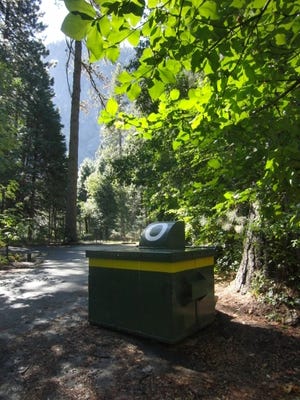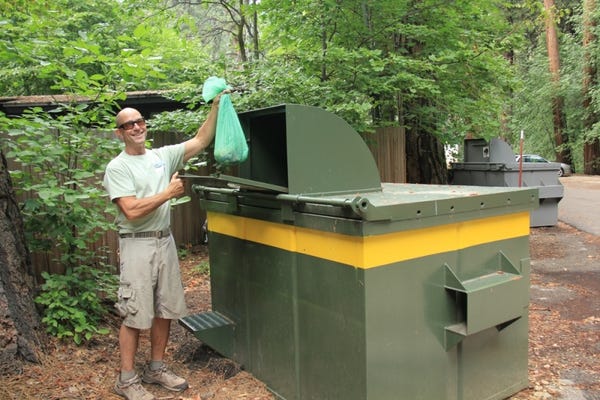Food Waste Composting at Yosemite National Park
By fully embracing food waste composting, Yosemite National Park has achieved impressive diversion numbers and slashed waste disposal costs.
 From developing biodegradable utensils for tourists to circumventing hungry bears, the concessioner at Yosemite National Park has faced its share of challenges in establishing a composting program for the area.
From developing biodegradable utensils for tourists to circumventing hungry bears, the concessioner at Yosemite National Park has faced its share of challenges in establishing a composting program for the area.
But Delaware North Companies (DNC) Parks & Resorts persevered, and they now operate an organics recycling program that draws raves from observers. “DNC has done a heck of a job. Above and beyond what you’d see in a lot of cases,” says Greg Ollivier, solid waste manager at Mariposa County, which operates the composting facility DNC supplies.
Through composting, DNC now is diverting more than 10 percent of the solid waste it was sending to the landfill, and the tonnage keeps going up. For its composting efforts DNC received an environmental achievement award this year from the U.S. National Park Service (NPS). “Delaware North’s efforts should serve as a model for other concessioners that have access to local large-scale industrial composting facilities,” NPS said in announcing the award.
But getting there wasn’t a walk in the park.
Sequoia-Sized Challenges
DNC has operated a successful recycling program at Yosemite since the 1990s. But recycling food waste and organics wasn’t practical until Mariposa County (which includes Yosemite) opened a composting facility in 2006. The problem for DNC with doing it in-park was limited space, odor — and bears. “Our concern was the bears would get into the organic waste,” says Mark Gallagher, environmental manager for DNC. “We couldn’t figure out a way to make it bear-proof.”
When the Mariposa County facility began operations, “It opened the door for us looking into diverting our organic waste,” he says.
DNC faced other challenges. One was Yosemite’s geographic position — the park is 48 miles away from the composting facility. That means high hauling costs. Another challenge was determining how to reduce or eliminate contamination once the program was open to the public, Gallagher says.
DNC came up with an efficient strategy for collection. “We did something really unique. We developed a system using the same truck to collect organics as [we used to collect] trash,” Gallagher says. Working with the hauler for the park, Total Waste Systems of Mariposa, they settled on first picking up the trash and then picking up the organic waste in biodegradable green bags. As a result, the front loader truck has the garbage in back and the organic waste in front. At the county tipping floor, the green bags are easily separated from the trash and the two streams are weighed separately.
“The main thing was to work out [a system] with Delaware North so we weren’t adding special trips, which would have added a great deal of cost,” says Stuart Katte, spokesman for Total Waste Systems.
The hauler was fine with the idea. “It doesn’t make any difference to us,” Katte says. “We’re happy to be a part of it.” Having the material brought in separated also is a great help to the county, he adds.
Breaking Down the Problem
On working with the public to help refine the waste entering the system, Gallagher says, “We had to eliminate, as much as possible, the non-organic [material].” That meant phasing out plastic dining goods. Finding the right substitutes “was a long process,” he says.
“The first thing was to find out what was compostable,” says Debora Sanches, environmental assistant manager for DNC. “We had to determine what works for us and the county and guest services.”
DNC product purchasers used a catalog to buy dining goods, and the process wasn’t standardized. Sanches says they educated the managers on what they were trying to accomplish and what some compostable options were. “It’s a constant effort that still being done. It took two years, maybe longer, to figure out what would work,” Sanches says.
She says some of the biodegradable products are more costly; the biodegradable bags are the highest. DNC encountered some resistance from managers in the beginning. But that eventually changed, in part because the managers found that eliminating buying options and standardizing purchases eliminated the substantial amount of waste that often occurs with food service ordering. “The food and beverage managers found out they’d save money,” she says.
“It works for our operations,” she says. “In the end we got the products that work for both of us and standardize the products.”
They replaced most of the cups and the utensils with biodegradable versions. The containers are made from plant starches, the dishware from potato starch products and the paper goods with recycled paper.
They wanted to change items such as poly-coated cups, but after testing them, to their pleasant surprise, DNC found out that they were compostable. They eliminated individual condiment packages and went to bulk. The concessioner reached the point that 95 percent of what they offered to the public was biodegradable. (That estimated remaining 5 percent is comprised of things like coffee cup lids and soup container lids — items for which compostable alternatives have been hard to source, according to Gallagher.) “Customers don’t have to separate,” Gallagher says. “They’re all able to put it into the container without worrying about what goes where.” But to further aid visitors, DNC also used photo signs posted on the receptacles that wordlessly illustrate what items go where. This helped clarify the process, Gallagher says, particularly for foreign visitors.
There are still challenges; DNC’s search for compostable coffee cups continues, for example.
High (Sierra) Praise
The composting program was launched in August 2009 at four locations: The Ahwahnee, Yosemite Lodge at the Falls, Degnan’s Deli and The Loft. The program was then expanded to include the kitchens at Curry Village, Village Grill, White Wolf Lodge, Tuolumne Meadows Lodge and the High Sierra camps. Each kitchen has a trash container for organics with liners made of compostable materials. NPS joined the composting effort there in October 2010 by collecting organic waste at its housing complex in Yosemite Valley. DNC expanded the program to its housing facilities this spring.
DNC added composting at a popular pizza restaurant at Curry Village this year. Their kitchen used to have three garbage dumpsters; now it has two for organic waste and one for garbage.
Composting started with the bigger and kitchens and sites and gradually has expanded to the more remote locations. The High Sierra Camps, which were started in the past year, are the most challenging locations yet due to their remoteness. The camps are accessible only by foot or saddle and free visitors from bringing camping gear. Gallagher says the attitude is if it can work there, it can work anywhere.
Mariposa County was a big help in the process, Gallagher says, and it still is. “Without their cooperation we wouldn’t have this project,” Sanches echos.
The county’s Ollivier is equally effusive in his praise of DNC. “They did a great job of doing their research,” he says. “Finding materials and making it easy to compost the materials.”
DNC and the county worked together throughout the process. “They were self-motivated,” says Ollivier of the concessioner. “We educated them told them what works best for us. DNC’s been very progressive and went forward on that. Very motivated to make it happen.”
The compostable material is easily identified, and it’s premium stuff, Ollivier says, because it’s generally free of contamination. It’s so easy to process that the county can get a “full cook” from the supply in a shorter period of time. In its in-vessel process, air is forced through the waste to produce a composting material in a quick 28 days. With other feedstocks it can take up to 38 days. “Twenty-eight days is about the fastest you can do,” Ollivier says.
Mariposa even gave DNC a financial break. Instead of charging them the usual $121 trash rate, they get charged the $55 organic rate per ton. DNC supplied Mariposa with 250 tons of organic waste last year and looks to collect 350 tons this year. The compost facility can process 80 to 100 tons per day. “When we get the material, we don’t have to touch it much. Which really cuts down on my costs,” “Ollivier says. “It only makes sense that we can pass that back to them.”
The material is good enough, he says, that Mariposa could sell it as a premium product. But currently they use it as alternative daily cover, as that’s more cost-effective at this point. As a premium product, “It’s not enough volume to make it cost effective. As their volume come up, we’ll get closer.”
“The great product benefits for us now are in savings of time,” Ollivier says.
There’s even a certain affection between the partners. “When the county sees our truck they call it the ‘DNC Special,’ ” Gallagher says.
“It’s worked well both ways because of the quality they (get),” adds Sanches.
El Capitans of Diversion
DNC’s diversion rate at Yosemite reached a plateau of about 40 percent before the composting addition. With the composting, it climbed to 53 percent last year. And that amount should get bigger, Sanches says, when a significant construction project begins soon, generating large volumes of construction and demolition waste that must be diverted. “That’s the next frontier,” she says.
“I think the organic waste collection effort is going to help us with our ultimate goal of zero waste,” Gallagher says, though he acknowledges that a more realistic goal is 80 percent.
 And the financial incentive is there as well. DNC last year sent 2,180 tons of trash to the landfill and paid about $250,000 in tipping fees. And of course, organic waste is heavy, which increases costs.
And the financial incentive is there as well. DNC last year sent 2,180 tons of trash to the landfill and paid about $250,000 in tipping fees. And of course, organic waste is heavy, which increases costs.
There’s a certain logic with this kind of environmental program in a park with the beauty of Yosemite. Gallagher agrees, but points out the more practical motivations. “Let’s face it, we have a fair amount of organic waste,” he says. “We have an opportunity to collect and divert that.”
And while it’s been an at-times arduous process for DNC to get where they are with their composting program, some aspects weren’t that hard, such as getting most of the DNC associates at the park to buy in.
“It didn’t take much,” Gallagher says. “They were behind it. After all, they work at Yosemite.”
Allan Gerlat is News Editor for Waste Age and waste360.com.
About the Author
You May Also Like


.png?width=300&auto=webp&quality=80&disable=upscale)